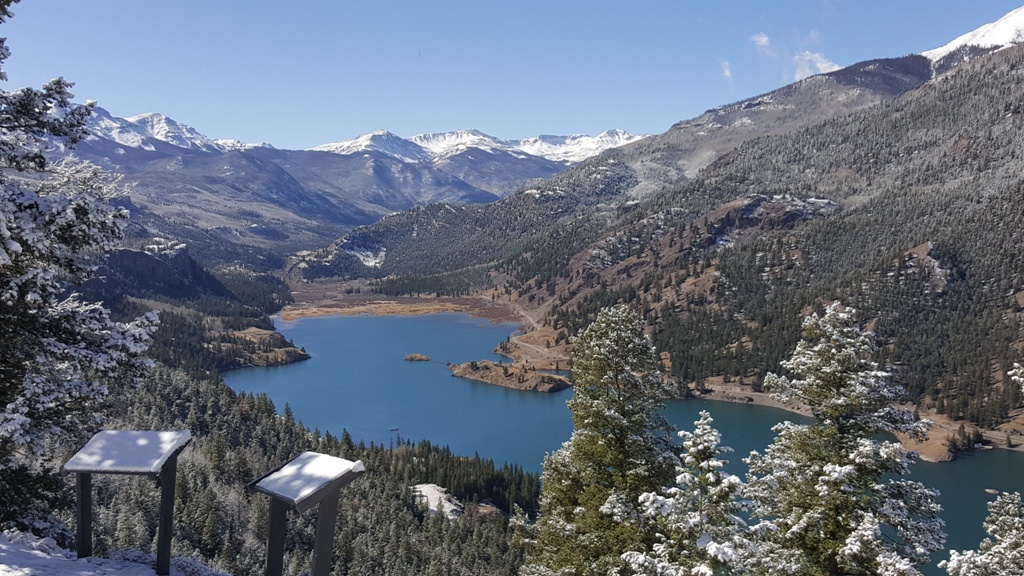
Photo taken by A. Danielle Worthen
Lake City Colorado Real Estate

Photo taken by A. Danielle Worthen
Comparing 2016 to 2017 in the Lake City area, New Listings were down 9.1 percent for single family homes. The Median Sales Price for single family homes went from $525,000 in 2016 to $262,500 in 2017 which is down 50 percent. The Average Sales Price for single family homes went from $575,000 in 2016 to $288,500 in 2017 which is down 49.8 percent.
Last year at this time, the national storyline was about how high demand was propping up sales and prices despite low inventory and months of supply. That has actually continued to be a familiar refrain for many months in 2017 and now for the past couple of years. But with the likes of Hurricanes Harvey and Irma, different employment outlooks, disparate incomes, varying new construction expectations and potential housing policy shifts, regional differences are becoming more prevalent and pronounced.
OHVs are allowed on all Hinsdale County and Town of Lake City roads.
OHV Regulations include:
Here is Hall Realty Broker, Scott Williams’ fishing report for May 4th from the Lake Fork of the Gunnison River semi-private section in the San Juan Ranch Estates Subdivision:
“In case anyone is asking… Fishing was GREAT today at San Juan Ranch.
Here are several Becky took.
What a place”
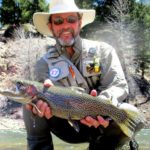
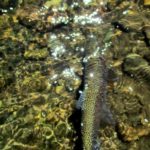
Fishing at San Juan Ranch today continued to impress. The fish were hitting
small nymphs (as you can see in the photo.)
The river is still wade worthy which makes it easy to get to the good spots!
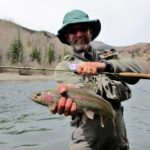
Photo by Becky Williams
I fished Highbridge section today with good results from about 11:00 to
1:00pm. I still didn’t see any surface takes but the viciousness of the
strikes along with observing the fish higher in the water column were good
signs! I caught several little ones plus some pretty fat medium-sized ones.
All hit nymphs but unlike earlier in the season, they were hitting the upper
nymph instead of the lower one. (Maybe my lower one just didn’t look very
good!) I did not catch as many as I might in that first week after the
major blowout subsides. However, for March fishing, it was pretty good
today. Also, the color of the rainbow trout is beginning to get beautiful.
Soon they’ll be spawning and the color will be even more dramatic
.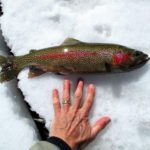
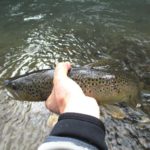

Hinsdale County Building Department Construction Planning Guidelines as of 1-1-2017
Hinsdale County Building Department
311 North Henson Street
P.O. Box 277
Lake City, CO 81235
970-944-2225
www.hinsdalecountycolorado.us
Town of Lake City, Colorado, Ordinance No. 2016-02
Section 2: 14.4 Off-Highway Vehicles.
(1) As used in this section, “off-highway vehicle” shall have the meaning given in Colorado Revised Statute § 33-14.5-101, as amended from time to time.
(2) As used in this Section, “public road” means and shall include any road, street, alley, avenue, thoroughfare, public way, or other public property within the Town of Lake City.
(3) It shall be lawful to operate off-highway vehicles on all public roads within the Town of Lake City, except public roads that are part of the state highway system, provided that:
a. The operator of the off-highway vehicle has in his or her possession a valid motor vehicle driver’s license or operator’s license.
b. The operator of the off-highway vehicle shall have in full force and effect a complying policy of insurance under the terms of Part 6, Article 4, Title 10, of the Colorado Revised Statutes, covering such off-highway vehicle.
(4) It shall be unlawful for any person to operate an off-highway vehicle on any public road in violation of the regulations of Title 42 of the Colorado Revised Statues pertaining to the movement of traffic on roadways within the Town of Lake City.
(5) It shall be unlawful for any person to operate an off-highway vehicle on any public road at a speed greater than fifteen miles per hour (15 m.p.h.).
(6) It shall be unlawful for any person to allow, authorize, suffer or permit an off highway-vehicle owned or belonging to him or her, or that is under his or her control, to be operated by any other person in violation of this Section.
(7) Any person convicted of a violation of this Section shall be subject to a fine not to exceed $300.00, for each separate violation.
(8) This Section shall be enforced by any law enforcement or peace officer, including the Hinsdale County Sheriff or a person designated by the Sheriff as the County Off-Highway Vehicle Enforcement Officer.
(9) Any fines collected by the Town of Lake City for violations of this Section shall be deposited to the Street and Alley fund.
The information provided is based primarily on language in Colorado House Bill 16-1005 and is intended to inform citizens on how to properly use rain barrels in accordance with Colorado law.
Rainwater collection, also called rainwater “harvesting” is the process of capturing, storing and directing rainwater runoff and putting it to use. Water from roof gutter downspouts is usually directed onto landscaped areas and is incidentally consumed by plants, but this form of use is not regarded as rainwater harvesting.
Colorado residents should understand that water rights in Colorado are unique compared to other parts of the country. The use of water in this state and other western states is governed by what is known as the prior appropriation doctrine. This doctrine of water allocation controls who uses water, how much water may be used, the typed of uses allowed, and when those waters can be used. A simplified way to explain this system is often referred to as the priority system or “first in time, first in right.”
Rain barrel use under HB16-1005: Under House Bill 16-1005, rain barrels can only be installed at single-family households and multi-family households with four (4) or fewer units. A maximum of two (2) rain barrels can be used at each household and the combined storage of the 2 rain barrels cannot exceed 110 gallons. Rain barrels can only be used to capture rainwater from rooftop downspouts and the caputred rainwater must be used on the same property from which the rainwater was captured, for only outdoor purposes, including to water outdoor lawns, plants and/or gardens. Rain barrel water cannot be used for drinking or other indoor water uses.
It is important for rain barrel users to understand that the capture and use of rainwater using rain barrels does not constitute a water right. HB16-1005 includes language that could result in the State Engineer curtailing the use of indiviual rain barrels if a water right holder can prove that those rain barrels have impacted their ability to receive the water that they are entitled to by virtue of their water right.
How much irrigation could I expect to accomplish with rain barrels? Each time you collect the maximum 110 gallons of water allowed in rain barrels, you can adequately irrigate approximately 180 square feet (a bit smaller than a 15 foot by 15 foot area) of vegetable garden or lawn area with the captured water. This estimate is based on CSU Extension recommendations to water lawns and vegetable gardens with about 1 inch of water during each irrigation cycle. However, a typical rain barrel user can only expect the rain barrels to completely fill aobut 10-15 times during the growing season, while vegetable gardens and lawns need to be irrigated at least twice as times per year depending on watering practices. Thus, supplemental irrigation will still be necessary to maintain a healthy lawn and vegetable garden.
For addtional information on the Colorado State University Extension Fact Sheet No. 6.707, please visit: http://extension.colostate.edu/topic-areas/natural-resources/rainwater-collection-colorado-6-707/
The Ute and Ulay mines were some of the best known silver and lead producers in Colorado. Between 1874 and 1903, the mines were responsible for $12 million worth of minerals, which today would amount to more than $280 million in value. Located in Hinsdale County, the mines were largely responsible for the development of Lake City. The booming mining-based economy attracted thousands of people to the area and the mines continued to remain in production on and off through the 1980’s.
Thanks to LKA Gold, the ten-acre site has been donated to Hinsdale County and the environmental stabilization work completed with the assistance of the Environmental Protection Agency (EPA), Colorado Department of Public Health & the Environment (CDPHE), and the Bureau of Land Management (BLM). The site consits of 18 structures including residential cabins, a blacksmith shop, a boarding house a red-cedar water tank, and assayer’s office. Over the past twenty years, the structures have continued to degrade during adverse weather and many are unstable. Due to the unsafe nature of the site, the public is currently not allowed near the buildings. A Historic Structures Assessment will need to be completed to determine each structure’s needs in order to stabilize the buildings for future reuse.
The Ute and Ulay mines, mill complex and surrounding Henson town site are rare examples of a more complete mining coummunity with large amount of historic fabric remaining. The site’s location along the Alpine Loop Backcountry Scenic and Historic Byway increases its opprotunity for eduation and a heritage tourism desination.
Colorado Preservation, Inc. (CPI) was founded in 1984 to promote historic preservation by providing information, education, training, expertise, and advocacy to Colorado communities and individuals. DPI engages leaders with local governments and non-profit organizations and assists historic property owners, educators, and interest citizens to develop successful preservation projects and programs. CPI administers Colorado’s Most Endangered Places Program (EPP), present the annual Saving Places Conference, hosts the Dana Crawford & State Honor Awards recognizing excellence in historic preservation, and maintains an active presence in the state legislatrue. CPI also provides services in grant and preservation program management, and undertaikes projects that serve as models for pereservation statewide.
(Taken from Colorado’s Most Endangered Places Issue No. 18 2015)
© Copyright 2018 Design by Agent Image - Real Estate Website Design | Sitemap

